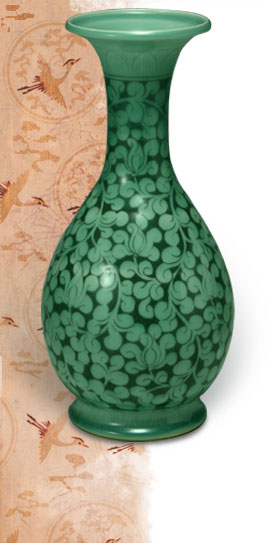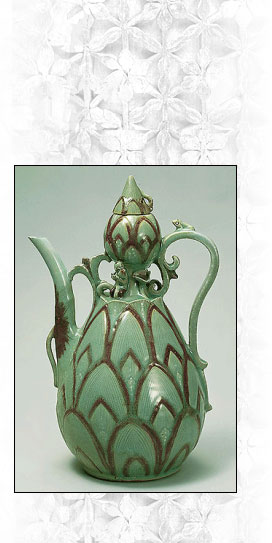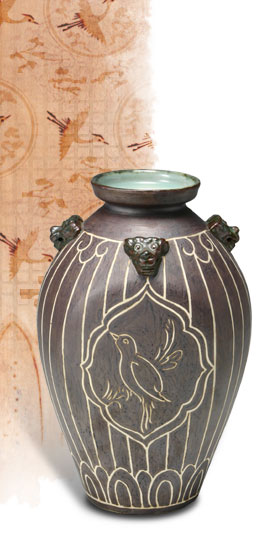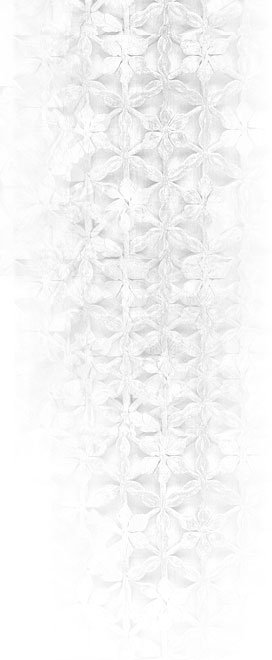 Thirdly,
the technique of underglazing with copper-paint in order to tint the celadon
ceramic red was attained by Thirdly,
the technique of underglazing with copper-paint in order to tint the celadon
ceramic red was attained by
 Goryeo potters
for the first time in the world. To create such an enhancement of beauty,
patterns are drawn on the Goryeo potters
for the first time in the world. To create such an enhancement of beauty,
patterns are drawn on the
 ceramic
using copper-based paint before applying the glaze. After being fired
at 1300˚C, the copper drawings turn ceramic
using copper-based paint before applying the glaze. After being fired
at 1300˚C, the copper drawings turn
 bright
red through the process of oxidation. This was the most elaborate and
beautiful coloring technique that had been bright
red through the process of oxidation. This was the most elaborate and
beautiful coloring technique that had been
 invented
in the history of ceramic crafts. Potters from Goryeo refrained from abusing
this technique, however, and only used invented
in the history of ceramic crafts. Potters from Goryeo refrained from abusing
this technique, however, and only used
 it minimally
to accentuate the harmony of different colors within the ceramic. Chinese
potters were not able to develop it minimally
to accentuate the harmony of different colors within the ceramic. Chinese
potters were not able to develop
 the system
to apply underglazing with copper-paint until the 14th century, 200 years
after Goryeo ceramic craftsmen. the system
to apply underglazing with copper-paint until the 14th century, 200 years
after Goryeo ceramic craftsmen.

 Gourd-shaped
Celadon Ewer Underglazed with Copper Red Gourd-shaped
Celadon Ewer Underglazed with Copper Red
 Goryeo,
13th Century Goryeo,
13th Century
 32.5cm
in height and 16.8cm in diameter at its widest point 32.5cm
in height and 16.8cm in diameter at its widest point
 The
abundant use of bright red copper underglazing on this The
abundant use of bright red copper underglazing on this
 unique
celadon ewer coexists perfectly with the color of blue unique
celadon ewer coexists perfectly with the color of blue
 sky
after a rainstorm during an autumn afternoon. The body sky
after a rainstorm during an autumn afternoon. The body
 is
shaped like a gourd with two lotus flowers of different sizes is
shaped like a gourd with two lotus flowers of different sizes
 on
top of each other. The flower on the lower body is slightly on
top of each other. The flower on the lower body is slightly
 opened
in the shape of a pond from which flower stems grow. opened
in the shape of a pond from which flower stems grow.
 A boy
sits on the neck holding a lotus bud in his hand dipping A boy
sits on the neck holding a lotus bud in his hand dipping
 his
feet into the pond while a small frog is poised to jump from his
feet into the pond while a small frog is poised to jump from
 the
handle, exemplifying vivid evidence of the Goryeo people’s the
handle, exemplifying vivid evidence of the Goryeo people’s
 deep
love of nature and rich imagination. The veins of each petal deep
love of nature and rich imagination. The veins of each petal
 are
delicately incised with copper-red outlines and occasional white are
delicately incised with copper-red outlines and occasional white
 dots
serving to further enliven the overall effect of subtle luxuriousness. dots
serving to further enliven the overall effect of subtle luxuriousness.

These achievements made great contributions to the development
of the ceramic crafts and arts in Korea and the world.
Some critics profoundly say that they also helped Goryeo celadon ceramic art move
one step closer to art’s divine function of
“purifying human minds with the power of beauty.” A great poet of the Goryeo Dynasty,
Yi Gyu-bo, said that Goryeo celadon is
made “by borrowing the magical power of heaven,” while his Chinese contemporaries praised
it with expressions such as,
“number one under heaven” and “extreme beauty.” Even today, many connoisseurs reveal their
admiration of Goryeo celadon
works by calling them “blessings of heaven” perfected by “God’s hands.”
The production of celadon ceramic art work that gave birth
to this splendid world of beauty entered a period of steady
decline paralleling the political and social turmoil during the late Goryeo Dynasty until
it gradually disappeared from the
ceramics sphere in Korea, making way for a new type of earthenware: Joseon Dynasty white
porcelain. Sadly, the world had
 been deprived
of the mysterious beauty of celadon for some 600 years until the vision
of one man came to be. been deprived
of the mysterious beauty of celadon for some 600 years until the vision
of one man came to be.
 Cho
Ki-jung, master celadon potter, was once a student of law who dreamt
of becoming a leader of the Cho
Ki-jung, master celadon potter, was once a student of law who dreamt
of becoming a leader of the
 nation’s
judicial branch. His interest in ceramic crafts first began when he was a
student at the Resources nation’s
judicial branch. His interest in ceramic crafts first began when he was a
student at the Resources
 Research
Association, studying how Korea, a poor agricultural country, could
promote economic Research
Association, studying how Korea, a poor agricultural country, could
promote economic
 development
by overcoming a lack of natural resources. He traveled to different
parts of the country to development
by overcoming a lack of natural resources. He traveled to different
parts of the country to
 look
for potential resources for his research. This is when he came across
countless kiln sites filled look
for potential resources for his research. This is when he came across
countless kiln sites filled
 with
broken pieces of ceramic art work hidden in various mountainsides. His discovery
revealed that with
broken pieces of ceramic art work hidden in various mountainsides. His discovery
revealed that
 there was something
in Jeollanam province that had promoted the development of ceramic art works there was something
in Jeollanam province that had promoted the development of ceramic art works
 yet left kilns and
ceramic pieces behind. He was particularly attracted to the kilns
in the town of Gangjin, yet left kilns and
ceramic pieces behind. He was particularly attracted to the kilns
in the town of Gangjin,
 known
as the home of Goryeo celadon. Fascinated with the glorious past of
celadon that disappeared known
as the home of Goryeo celadon. Fascinated with the glorious past of
celadon that disappeared
 into
history along with the Goryeo Dynasty, Cho decided that he would revive
the wonders of this lost history. into
history along with the Goryeo Dynasty, Cho decided that he would revive
the wonders of this lost history.
 However,
because celadon making techniques were not left on record and were essentially
extinct, he However,
because celadon making techniques were not left on record and were essentially
extinct, he
 had
to train himself in this specialized art, mainly through experimentation.
He first focused on the earth from had
to train himself in this specialized art, mainly through experimentation.
He first focused on the earth from
 which
ceramic art work is made. He used different combinations of silica, feldspar,
limestone, terra alba, which
ceramic art work is made. He used different combinations of silica, feldspar,
limestone, terra alba,
 and clay (the
most common elements of ceramic) in his experiments and ceramic
art works. and clay (the
most common elements of ceramic) in his experiments and ceramic
art works.
 He
then combed through the mountains of Korea to look for high-quality
ingredients. He fetched earth and stones He
then combed through the mountains of Korea to look for high-quality
ingredients. He fetched earth and stones
 of
extraordinary qualities from all across the nation. It is said that
he wandered over a mountain for 15 days in search of
extraordinary qualities from all across the nation. It is said that
he wandered over a mountain for 15 days in search
 for rocks
that could be used for the iron-paint underglaze, during which he slept
on dirt and ate dried breadcrumbs. His efforts were not in vain, though,
and Cho was able to create an iron-painted ceramic art piece. for rocks
that could be used for the iron-paint underglaze, during which he slept
on dirt and ate dried breadcrumbs. His efforts were not in vain, though,
and Cho was able to create an iron-painted ceramic art piece.
View the master's
works |


















